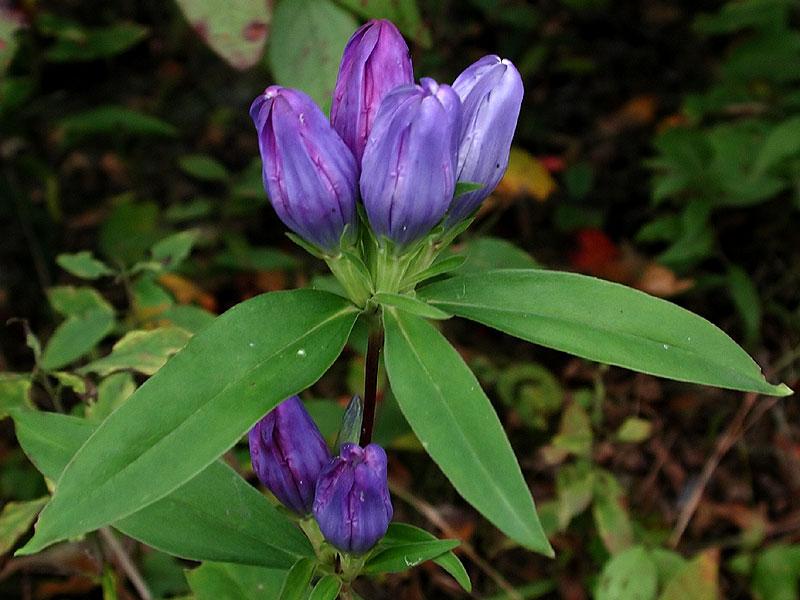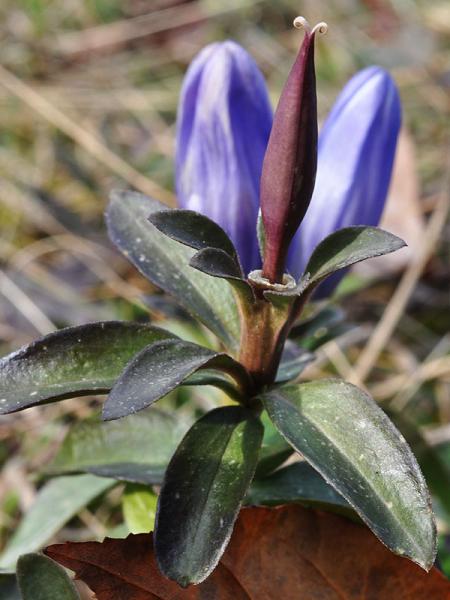Soapwort Gentian
Gentiana saponaria L.
- Class
- Dicotyledoneae (Dicots)
- Family
- Gentianaceae (Gentian Family)
- State Protection
- Endangered
Listed as Endangered by New York State: in imminent danger of extirpation in New York. For animals, taking, importation, transportation, or possession is prohibited, except under license or permit. For plants, removal or damage without the consent of the landowner is prohibited.
- Federal Protection
- Not Listed
- State Conservation Status Rank
- S1
Critically Imperiled in New York - Especially vulnerable to disappearing from New York due to extreme rarity or other factors; typically 5 or fewer populations or locations in New York, very few individuals, very restricted range, very few remaining acres (or miles of stream), and/or very steep declines.
- Global Conservation Status Rank
- G5
Secure globally - Common in the world; widespread and abundant (but may be rare in some parts of its range).
Summary
Did you know?
The leaves are too bitter for most herbivores to eat but that doesn't keep deer from biting off the flowers (Hilty, John 2009).
State Ranking Justification
There are two existing populations on Staten Island, both with under 100 plants each. Most of the 37 historical sites have been developed.
Short-term Trends
There have not been enough recent surveys to determine the short-term trend.
Long-term Trends
There has been a sever decline of populations over the last 100 years as the western end of Long Island and New York City has been developed and wetlands have been lost.
Conservation and Management
Threats
Loss of wetland habitat is the primary threat.
Conservation Strategies and Management Practices
The wetland habitats need to remain with an open canopy. Access to the existing populations should be restricted to prevent picking or trampling.
Research Needs
Research is needed into the best approach to augment existing populations.
Habitat
Habitat
In New York these wildflowers have been found in wet areas of successional deciduous woodlands, a freshwater swale at the border of a salt marsh, a wet switchgrass meadow, mixed mesophytic forests, a hillside fen, a shrub swamp, and damp areas of the Hempstead Plains (New York Natural Heritage Program 1998). Glades, sandy swamps, shores and bogs (Fernald 1970). Moist woods and thickets (Gleason & Cronquist 1991).
Associated Ecological Communities
- Coastal oak-beech forest*
(guide)
A hardwood forest with oaks and American beech codominant that occurs in dry well-drained, loamy sand of morainal coves of the Atlantic Coastal Plain. Some occurrences are associated with maritime beech forest.
- Coastal plain poor fen*
(guide)
A wetland on the coastal plain fed by somewhat mineral-rich groundwater and slow decomposition rates of plant materials in the wetland (and thus develops peat). Plants are generally growing in peat composed primarily of Sphagnum mosses with some grass-like and woody components.
- Hempstead Plains grassland
(guide)
A tall grassland community that occurs on rolling outwash plains in west-central Long Island. This community occurs inland, beyond the influence of offshore winds and salt spray.
- Red maple-hardwood swamp*
(guide)
A hardwood swamp that occurs in poorly drained depressions, usually on inorganic soils. Red maple is usually the most abundant canopy tree, but it can also be codominant with white, green, or black ash; white or slippery elm; yellow birch; and swamp white oak.
- Red maple-sweetgum swamp
(guide)
A hardwood swamp that occurs on somewhat poorly drained seasonally wet flats, usually on somewhat acidic soils. Red maple-sweetgum swamps often occur as a mosaic with upland forest communities. Sweetgum is often the dominant tree or may be codominant with red maple. Other codominant trees include pin oak and blackgum.
- Sea level fen*
(guide)
A wetland that occurs at the upper edge of salt marshes but is fed primarily by acidic groundwater seeping out along the upland edge. This fresh water sometimes mixes with salt or brackish water during unusually high tides. There is a high abundance of sedges that decompose slowly and create a deep substrate of peat. This peat is underlain by deep sand or gravel. These fens usually have a high diversity of herbs but may also have scattered trees and shrubs.
- Successional southern hardwoods
A hardwood or mixed forest that occurs on sites that have been cleared or otherwise disturbed. Canopy trees are usually relatively young in age (25-50 years old) and signs of earlier forest disturbance are often evident. Characteristic trees and shrubs include any of the following: American elm, slippery elm, white ash, red maple, box elder, silver maple, sassafras, gray birch, hawthorn, eastern red cedar, and choke-cherry.
* probable association but not confirmed.
Associated Species
- Acer rubrum
- Betula
- Eupatorium
- Juncus greenei (Greene's rush)
- Lilium superbum (Turk's-cap lily)
- Liquidambar styraciflua (sweet-gum)
- Lyonia ligustrina
- Panicum virgatum (switch grass)
- Rhus copallinum
- Smilax rotundifolia (common greenbrier)
- Solidago Pagosa
Range
New York State Distribution
This herb historically ranged from Suffolk County on Long Island west, and north to Dutchess County. It is currently only known from Staten Island as it is now considered extirpated in the rest of New York City.
Global Distribution
This is primarily a species of the southeastern US where it extends southwest to Arkansas and Oklahoma, where it is rare, and eastern Texas and Louisiana. It also grows south of Lake Michigan in Indiana and Illinois with a disjunct population in central Wisconsin. It is considered extirpated in Michigan and rare in Ohio. It reaches its northeastern limit in Pennsylvania, New Jersey and New York, where it is also rare.
Identification Comments
General Description
This wildflower is 2-7 dm tall and has glabrous stems. The leaves are oblong to narrowly elliptic and ciliolate at 10X. The anthers are not divided. The calyx lobes are firm, oblong to oblanceolate, ascending, and ciliolate at 10X magnification. The blue corolla is cylindric-oblanceolate, 1-1.5 cm in diameter and slightly open at the summit at anthesis. The purplish to blue lobes are erect and only slightly longer than the plaits.
Identifying Characteristics
Distinguishing characteristics: stem glabrous; leaves oblong to narrowly elliptic, ciliolate at 10X; involucre of 2-4 leaves, the outer 3-6.5 cm long and 0.7-2 cm broad; anthers connate; calyx lobes firm, oblong to oblanceolate, ascending, ciliolate at 10X; corolla cylindric-oblanceolate 1-1.5 cm in diameter at the slightly open summit, more or less open at anthesis; purplish lobes erect, only slightly long than the appendages. Best life stage for ID: in flower. Characteristics needed to ID: stem with mature flowers.
Best Life Stage for Proper Identification
The best time to identify this species is when it has stems with mature flowers.
Similar Species
This is the only bottle gentian in New York that has long, narrow, ciliate calyx lobes, fringe or "plaits" shorter than the petal lobes so the flowers are not white at the top when closed. Its corolla is slightly open at anthesis. The other two similar species, G. andrewsii and G. clausa have not been seen on the coastal plain in decades.
Best Time to See
The plants flower from mid-September to mid-November, one of the latest blooms of the year.
- Flowering
- Fruiting
The time of year you would expect to find Soapwort Gentian flowering and fruiting in New York.
Soapwort Gentian Images
Taxonomy
Soapwort Gentian
Gentiana saponaria L.
- Kingdom Plantae
- Phylum Anthophyta
- Class Dicotyledoneae
(Dicots)
- Order Gentianales
- Family Gentianaceae (Gentian Family)
- Order Gentianales
- Class Dicotyledoneae
(Dicots)
- Phylum Anthophyta
Additional Resources
Best Identification Reference
Gleason, Henry A. and A. Cronquist. 1991. Manual of Vascular Plants of Northeastern United States and Adjacent Canada. The New York Botanical Garden, Bronx, New York. 910 pp.
Other References
Clemants, Steven and Carol Gracie. 2006. Wildflowers in the Field and Forest. A Field Guide to the Northeastern United States. Oxford University Press, New York, NY. 445 pp.
Fernald, M.L. 1950. Gray's manual of botany. 8th edition. D. Van Nostrand, New York. 1632 pp.
Holmgren, Noel. 1998. The Illustrated Companion to Gleason and Cronquist's Manual. Illustrations of the Vascular Plants of Northeastern United States and Adjacent Canada. The New York Botanical Garden, Bronx, New York.
New York Natural Heritage Program. 2010. Biotics database. New York Natural Heritage Program. New York State Department of Environmental Conservation. Albany, NY.
New York Natural Heritage Program. 2024. New York Natural Heritage Program Databases. Albany, NY.
Newcomb, Lawrence. 1977. Newcomb's Wildflower Guide: An Ingenious New Key System for Quick, Positive Field Identification of the Wildflowers, Flowering Shrubs, and Vines of Northeastern and North-Central North America. Little, Brown and Company. Boston.
Reschke, Carol. 1990. Ecological communities of New York State. New York Natural Heritage Program, New York State Department of Environmental Conservation. Latham, NY. 96 pp. plus xi.
Weldy, T. and D. Werier. 2010. New York flora atlas. [S.M. Landry, K.N. Campbell, and L.D. Mabe (original application development), Florida Center for Community Design and Research http://www.fccdr.usf.edu/. University of South Florida http://www.usf.edu/]. New York Flora Association http://newyork.plantatlas.usf.edu/, Albany, New York
Links
About This Guide
This guide was authored by: Stephen M. Young
Information for this guide was last updated on: September 20, 2012
Please cite this page as:
New York Natural Heritage Program. 2024.
Online Conservation Guide for
Gentiana saponaria.
Available from: https://guides.nynhp.org/soapwort-gentian/.
Accessed July 26, 2024.

